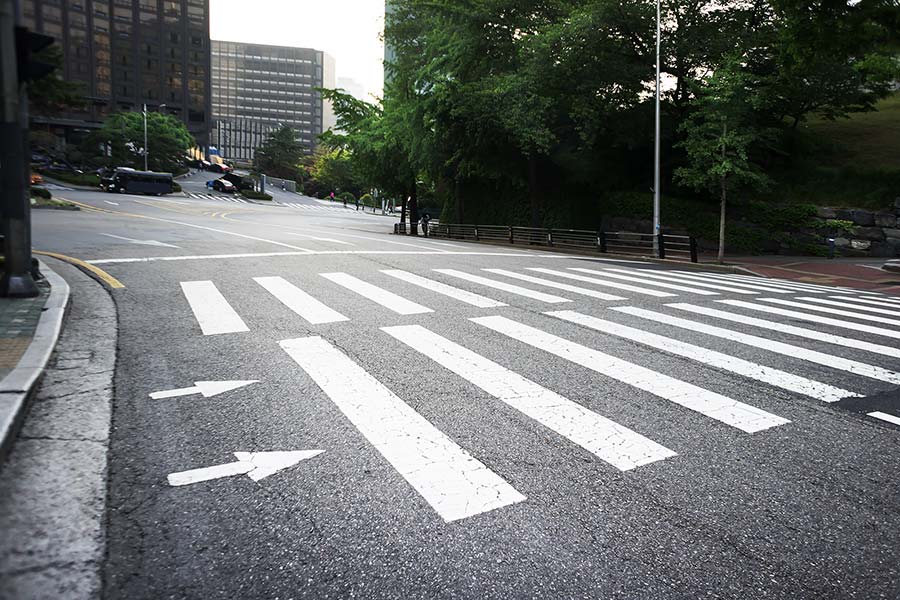Pedestrian Accidents
A pedestrian is a person who is on foot and active in areas where traffic exists. Most people think they know what a pedestrian is when they see one, but you may not realize how wide the definition of “pedestrian” really is. You may have a pedestrian accident injury case if you were:
- Walking
- Standing
- Sitting
- Lying down
- Running
- Hiking
When a driver or a pedestrian fails to exercise proper care, an accident can occur, causing catastrophic injury or fatality. If you were doing any of these things when someone else struck you, you may have a case against them.
At Crane Law, we handle employment, discrimination and personal injury cases throughout Michigan. Since 1995, Steve Crane has successfully represented persons like you.
As an experienced lawyer, Steve can gauge when it makes sense to go to court. He knows that a letter or phone call — with proper wording and timing — can be more effective or cost-efficient than suing for damages or injunctive relief.
For those cases that must be presented to a judge or jury, he is eminently qualified to assert your interests.
If you have sustained a workplace injury, call Steve free. He and his team can assess the facts of your case and help you determine the best course of action to move forward.
To schedule a discrete and confidential consultation about your matter, call Steve free at (888) 855-4400.
Do I have a pedestrian accident case?
We represent clients on a contingency fee basis with no upfront payments necessary. In this type of arrangement, we do not collect attorney’s fees unless and until our clients recover compensation in a settlement offer or court award.
If you suffered injuries in a pedestrian accident, we may be able to:
- Investigate your accident.
- Identify the liable party.
- Pursue compensation on your behalf.
We will also handle all communications, deadlines, and paperwork in your case while you concentrate on your recovery. Recoverable damages could include the costs of your medical bills, lost wages, pain and suffering, and more.

Where do most pedestrian accidents occur?
According to a recent report on pedestrian traffic fatalities by the National Highway Traffic Safety Administration (NHTSA), pedestrian fatalities per year steadily decreased from the late 1970s to 2009, when the United States reached a low of 4,109 deaths. However, the number of pedestrian fatalities has increased since 2009, leading to a 5-year average of 6,502 pedestrian deaths during the 5 most recent years (2017 to 2021). During this period, pedestrians accounted for 16 or 17% of total traffic fatalities.
In 2021, some 7,388 pedestrians died, and approximately 60,577 were injured in traffic crashes in the United States (NCSA, 2023c).
Characteristics of fatal crashes involving pedestrians include:
- Light conditions: 76% of pedestrians were killed in collisions that occurred when it was dark, with another 4% occurring during dusk or dawn (Schneider, 2020). Retting (2021) notes that during the years 2010-2019 —a time when pedestrian fatalities have been increasing—the number of pedestrian fatalities that occurred in the dark increased by 58%, while daylight fatalities increased by 16%.
- Roadway location: 73% of pedestrian fatalities occurred at non-intersection locations (Schneider, 2020). A study linking FARS data with roadway data and aerial imagery to identify pedestrian fatality “hot spots” found that common characteristics of these locations included five or more lanes to cross (70%), speed limits of 30 mph or higher (75%), and traffic volumes exceeding 25,000 vehicles per day (62%) (Schneider et al., 2021).
- Time: 25% of all pedestrian fatalities occurred from 6 p.m. to 8:59 p.m. and 26% from 9 p.m. to 11:59 p.m. (NCSA, 2023c)
- Hit-and-run: 23% of pedestrian fatalities in 2021 involved hit-and-run drivers (NCSA, 2023c), a proportion that has remained consistent for decades (Schneider, 2020). Investigators and researchers may never know about the characteristics of the driver or the vehicle involved. As with other crash problems, there can be significant regional variation; an analysis of FARS data from 1998 to 2007 found that hit-and-run crashes accounted for 6.6.% of pedestrian fatalities in Mississippi and 29.8% in the District of Columbia (MacLeod et al., 2012). Common environmental and temporal factors surrounding hit-and-run crashes include poor lighting conditions, early morning time frame, and occurrence on the weekend.

Characteristics of pedestrians fatally injured in crashes include:
- Sex: 70% of pedestrians killed were males. Walking rates are similar for men and women (Buehler et al., 2020), but men are more than twice as likely to be killed in a traffic crash as pedestrians (NCSA, 2023c).
- Age: The age groups 60 to 64 and 65 to 70 had the largest percentage of pedestrian fatalities (23%), with the age group 60 to 64 having the highest fatality rate (3.18 per 100,000 population). The average age of pedestrians killed has remained similar over the past 10 years (ranging from 45 to 48). Adults over 65 walk less than other age groups, yet in 2021, 18% of all pedestrian fatalities with known age were 65 and older. Adults 65 and older comprise 15% of the population. Older pedestrians are more likely to die from their injuries when struck due to the inherent fragility associated with the aging process.
- Factors that may increase vulnerability to being struck for some older pedestrians include age-related physical changes that lead to walking more slowly;
- Difficulty crossing the curb; difficulty judging walking speeds and oncoming vehicle speeds; difficulty in interactions with turning vehicles at intersections; and
- Possible confusion about pedestrian signal phases.
- Race/ethnicity/national origin: Several studies have documented the overrepresentation of Black and American Indian or Alaska Natives in pedestrian-motorist crashes as well as immigrants and areas with low incomes. These racial disparities, aggregated at the national level, remain when controlling for population as measured by the Census and for pedestrian activity as measured by walking trips or distances by the NHTS. Some studies attribute the inequities to how pedestrian facilities are distributed within communities. Other studies have found that areas with lower income and minority populations have higher transit use and walking rates (or exposure) that may partially explain elevated crash figures.
They also commonly occur on shared paths, driveways, medians, sidewalks, bicycle lanes, parking lanes, and roadsides. The NHTSA also reports that most fatal pedestrian accidents happen at night.
Areas where most pedestrian accidents occur
On average, a pedestrian dies every 84 minutes in a traffic crash, according to the NHTSA. Many of these accidents occurred at night or when other factors limited visibility.
These accidents were most likely to occur in areas such as:
Urban Areas
The NHTSA reports that 81 percent of all fatal pedestrian accidents occurred in urban areas in 2018. The main reason for this is the high level of concentrated pedestrians and motorists’ side-by-side in metropolitan areas.
Both motorists and pedestrians must always be on high alert when navigating through dense traffic in shared areas. The slightest distraction or error in judgment can lead to an accident.
Intersections
The NHTSA data shows that 74 percent of pedestrian fatalities in 2021 occurred on sections of the road with no intersection. This means they were likely hit while walking along the road or otherwise sharing spaces with motorists.
However, even with signals, signage, and right of way protections, the NHTSA reports that 17 percent of fatal pedestrian accidents occurred in intersections.
Accidents between cars and pedestrians can occur at intersections when they must cross the path of motorists and those motorists fail to yield. This can happen when the pedestrian is:
- Crossing in front of a motorist going straight
- Crossing in front of a motorist while they are turning right.
- Crossing in front of a motorist turning left
Some of the main reasons why accidents occur at intersections include:
- Failing to assess a situation accurately.
- Incorrectly assuming what a driver or pedestrian will do.
- Proceeding with limited visibility
- Traffic violations such as U-turns
- Distracted driving
- Poor judgment about the distance between cars
- Other forms of negligence
Roadsides or Shoulders
People often walk in areas not specifically designated for pedestrians. These areas include highways or busy streets with narrow shoulders or no sidewalks. Motorists in these areas may not expect pedestrians to be present.
These drivers are not ready to encounter individuals or groups walking along these roads. However, they are still responsible for navigating in a way that keeps the pedestrians safe.
Parking Areas
Parking areas are among the most challenging places to navigate because of narrow lanes and many pedestrians. Numerous objects and vehicles may reduce visibility, increasing the risk of an accident. Furthermore, drivers may be in a hurry to beat other drivers to prime parking spots.
Accidents often occur in parking lots because of someone not looking before backing up. Also, a pedestrian may walk past a car without noticing the reverse lights. Distracted driving and walking both cause pedestrian accidents in parking lots.
Shared use Paths or Trails
Cars are not the only vehicles that get into accidents with pedestrians. Bicycles, motorcycles, scooters, skateboards, and even roller blades can present risks on shared-use paths or trails.
For instance, instead of using a bicycle lane on the street, a cyclist may choose to ride on the sidewalk. This can lead to an accident that causes serious injuries to the pedestrian, the cyclist, or both. This is one reason why it is illegal to ride a bicycle on the sidewalk in many areas.
Especially in crowded areas and when those involved cannot hear or see other traffic around them, pedestrians and skaters, riders, or others can collide. These accidents can lead to severe injuries, and victims may be in recovery for long periods.
